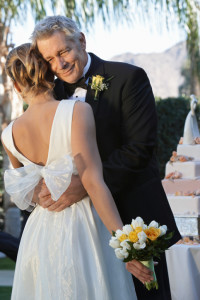It is customary to have music and dancing at Canadian weddings. Many receptions include various dance traditions to honor the wedding party and encourage guests to participate in the fun on the dance floor.
Customary Schedule of Wedding Dances
- Newlyweds
Since the Victorian era, it has been traditional for newlyweds to dance first to kick off the party, and 90 percent of weddings today have a first dance, according to weddingindustrystatistics.com. Many couples dance immediately after they make their grand entrance. Some do it during the reception dinner to break up the meal. The first dance is typically one of the most highly anticipated moments of a wedding.
- Parent Dances
After the new couple dances, it is customary for each of the spouses to dance with their parents. Sometimes the two couples are on the dance floor together, and sometimes it happens independently. After that transpires, each partner frequently dances with his or her in-laws. Since there are many non-traditional families these days, dances may actually be with step-parents, grandparents, uncles, siblings or dear friends, rather than parents. In order to keep everyone’s attention, some wedding planners suggest playing songs that are two minutes or less for this group of dances.
- Wedding Party
The wedding party is often the next group on the dance floor with flower girls, ring bearers and ushers participating as well. The music is usually upbeat and designed to get the festivities going. After the wedding party dances, the rest of the guests are invited to join in the merrymaking.
Cultural Dances
Cultural dances are a fun part of many wedding receptions. Two popular ones are:
- Money Dance
The money dance, also called the dollar dance, is popular in North and South America as well as Europe. It often takes place at the very end of the reception. Guests are given the opportunity to dance with the newlyweds after they give them a few dollars. The bills may be pinned to the bride’s veil or dress or collected by the maid-of-honor. The best man may also offer shots of whiskey to guests beforehand.
- Hora
The Hora is customarily performed at Jewish weddings to the music of Israeli folk songs. Hava Nigila is the song most traditionally associated with this dance. To begin, the guests hold hands and form a circle. They put the left foot forward, followed by the right, while rotating around in a circle. Concentric circles may form around the original circle. The bride, seated on a chair, may be lifted above the dancers.
Quebec Sock Dance
One uniquely Canadian dance is the Quebec sock dance. It typically takes place after the other traditional dances. It involves any older unmarried siblings of the groom putting on ugly colored socks and dancing. The socks are supposed to stand for these family members having “cold feet” about tying the knot themselves. The funnier the participants are, the better. Guests frequently throw money at the feet of the dancers that is intended for the newly married couple.
Popular Songs for the First Dance
While couples can use any song they want for their first dance, there are a few choices that are routinely picked by newlyweds. Here are ten:
- At Last by Etta James
- Into the Mystic by Van Morrison
- I Won’t Give Up by Jason Mraz
- Better Together by Jack Johnson
- For Once in My Life by Stevie Wonder
- The Luckiest by Ben Folds
- You Are the Best Thing by Ray LaMontagne
- A Thousand Years by Christina Perri
- Your Song by Ellie Goulding
- Come Rain or Come Shine by Billie Holiday
Dancing is an integral part of many wedding receptions. Tradition inspires many dances, but the activity is also a great way to bring family and guests together and liven up the festivities.


